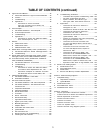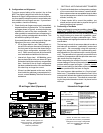
9
SECTION 2 - AIR FLOW AND HEAT TRANSFER
B. Configuration and Alignment
To ensure proper baking of the product, the air flow
MUST be properly aligned as it exits the air fingers.
Because air finger configurations are tested at the fac-
tory for a specific customers product, severe bake prob-
lems related to the air fingers are rare. If you encoun-
ter a problem, check the following:
1. Check that the air fingers are properly assembled,
cleaned and free of obstructions. For the standard
air fingers shown in Figure 4, a variety of styles are
available for each of the three components. It is
often possible to assemble these components in-
correctly, as they are designed to be modular. This
will affect the quality of the bake.
If you need information on the correct air finger con-
figuration of the oven, check the following:
3D air finger label or card. Many current ov-
ens will have a three-dimensional drawing on
the front panel of the oven that shows the cor-
rect air finger configuration, as shown in Fig-
ure 5. Other ovens may have this information
on a laminated card attached to the oven.
Internal air finger chart. All Middleby ovens
have a chart similar to the one shown in Figure
6 attached inside the machinery compartment
door. Note that if the air finger configuration
has been updated since the oven was installed,
this chart may no longer be correct.
If there is no label present on the oven, and the
chart inside the machinery compartment is in-
correct, contact Middleby Technical Service for
assistance.
2. Check that the bake time and temperature settings
of the oven match the customers specifications.
Most customers have an acceptable range for bake
time and temperature to allow for local variations in
altitude, humidity, etc.
3. If these checks fail to correct the problem, you
should perform a test bake to pinpoint the type of
baking problem that is present.
C. Performing a Test Bake
Before you attempt to correct any problem, please CON-
FIRM THAT THERE IS ACTUALLY A PROBLEM. It is
extremely difficult to tell if an oven is baking unevenly
by simply looking at a pizza with ingredients, espe-
cially if the pizza is a large combination-type. Often,
the ingredients and toppings themselves can cause an
uneven bake.
The best way to check for an uneven bake is to make a
test bake with a consistent, predictable product and
then read it. We recommend using the customers
dough (for a pizza product) OR a commercially-avail-
able pancake mix (for customers with a variety of prod-
ucts). The pancake mix is generally more sensitive to
variations in temperature and thus provides more accu-
rate results than the dough test.
When interpreting the results of the test, consistently
uneven baking on the top of the product may indicate a
problem with the upper air fingers. Likewise, consis-
tently uneven baking on the bottom of the product may
indicate a problem with the lower air fingers.
The most common bake problem is a front-to-back
bake issue. This problem occurs when the front of the
conveyor belt (towards the window) receives more heat
than the rear, or vice-versa. This results in uneven bak-
ing for the product based on where it is placed on the
conveyor.
Figure 5
3D air finger label (if present)
NOTE: Labels of this type are not
used on all ovens. Label placement
and design will vary based on
customer preference.
Figure 6
Internal air finger chart
NOTE: All ovens use a chart of this
type inside the machinery compartment.
Changes to the air finger configuration
after oven installation MAY NOT BE
INDICATED.


















